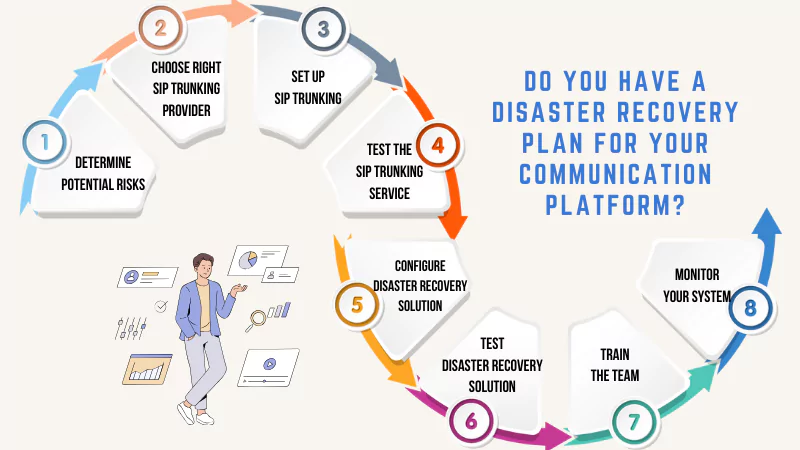Disasters, whether natural or man-made, can significantly impact a business’s operations. They can cause disruptions, lead to financial losses, and even result in the closure of the business. As such, it’s essential to have a disaster recovery plan in place to ensure business continuity. One way to achieve this is through the implementation of SIP Trunking, which allows businesses to use the internet to make and receive calls instead of traditional phone lines. SIP Trunking can also provide a reliable disaster recovery solution, ensuring that businesses can continue to communicate even during a disaster. In this guide, we’ll provide a step-by-step manual for implementing SIP Trunking and Disaster Recovery to ensure business continuity.
Step 1: Determine your disaster recovery plan.
The first step in implementing a disaster recovery plan is to determine the potential risks that your business faces. You should evaluate your business operations and identify the critical components that need to be protected in the event of a disaster. For example, if your business relies heavily on phone communication, you should ensure that your phone system is protected and has a disaster recovery solution in place.
Step 2: Choose the right SIP Trunking provider
Look for a reliable and trusted SIP Trunking provider that offers disaster recovery solutions. The provider should offer options for automatic failover, redundant servers, and multiple data centers to ensure business continuity. Ensure that your provider has a good track record of uptime and reliability, as well as a strong reputation for customer support.
Step 3: Set up SIP Trunking
Once you have selected a SIP Trunking provider, it’s time to set up your SIP Trunking service. Your SIP Trunking provider will provide you with the necessary configuration details to set up your system. Follow the instructions provided by your provider to configure your SIP Trunking service.
Step 4: Test the SIP Trunking service
Before you go live with your SIP Trunking service, it’s important to test the service to ensure that it’s working correctly. Perform various tests to ensure that your SIP Trunking service is working as expected and that you’re ready for any disaster that may occur. Test your SIP Trunking service with a variety of scenarios, including placing calls, receiving calls, and transferring calls.
Step 5: Configure your Disaster Recovery solution
Your SIP Trunking provider will provide you with instructions on how to configure your Disaster Recovery solution. This includes setting up automatic failover, redundant servers, and multiple data centers. Ensure that your disaster recovery solution is set up correctly and tested. Your disaster recovery solution should include a failover mechanism to ensure that if the primary system fails, the backup system will automatically take over.
Step 6: Test your Disaster Recovery solution
After configuring your Disaster Recovery solution, it’s essential to test it to ensure that it’s working correctly. Perform various tests to simulate a disaster and ensure that your disaster recovery solution is working as expected. For example, test your Disaster Recovery solution by disconnecting the primary system, and ensuring that the backup system takes over seamlessly.
Step 7: Train your team
Ensure that your team is trained on how to use SIP Trunking and the Disaster Recovery solution. Provide them with the necessary information and instructions on what to do in the event of a disaster. Ensure that your team understands the importance of business continuity, and how the Disaster Recovery solution can help them maintain communication during a disaster.
Step 8: Monitor your system
Once you’ve implemented SIP Trunking and the Disaster Recovery solution, it’s essential to monitor your system regularly. This includes monitoring your SIP Trunking service and your Disaster Recovery solution to ensure that they’re working correctly. You should also regularly test your Disaster Recovery solution to ensure that it’s still working as expected.
By following these steps, you can ensure that your business is prepared for any disaster and that your business continuity is maintained. SIP Trunking and Disaster Recovery provide an excellent solution for businesses that rely heavily on phone communication, and they can help ensure that your business can continue to operate during and after a disaster.





